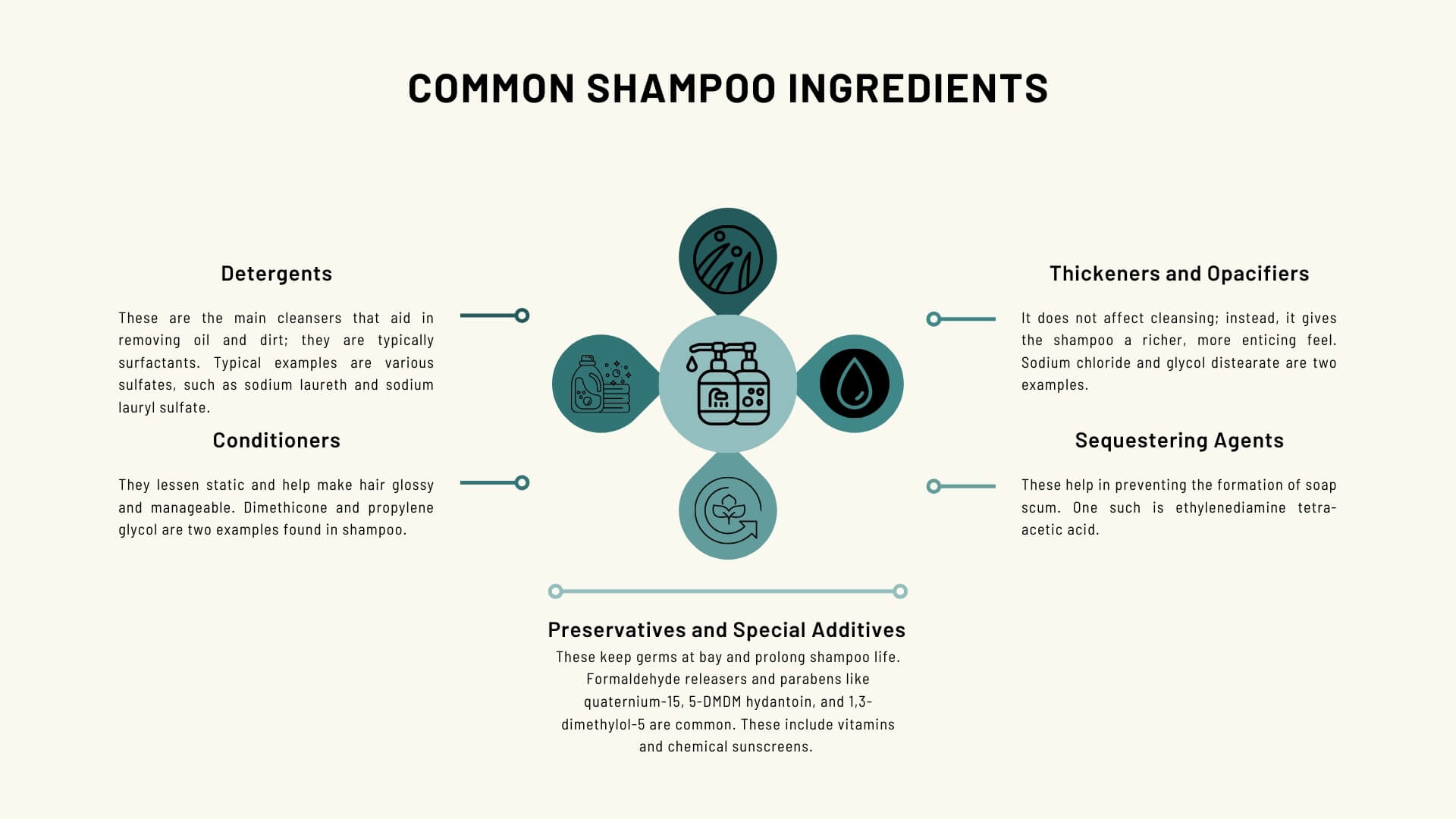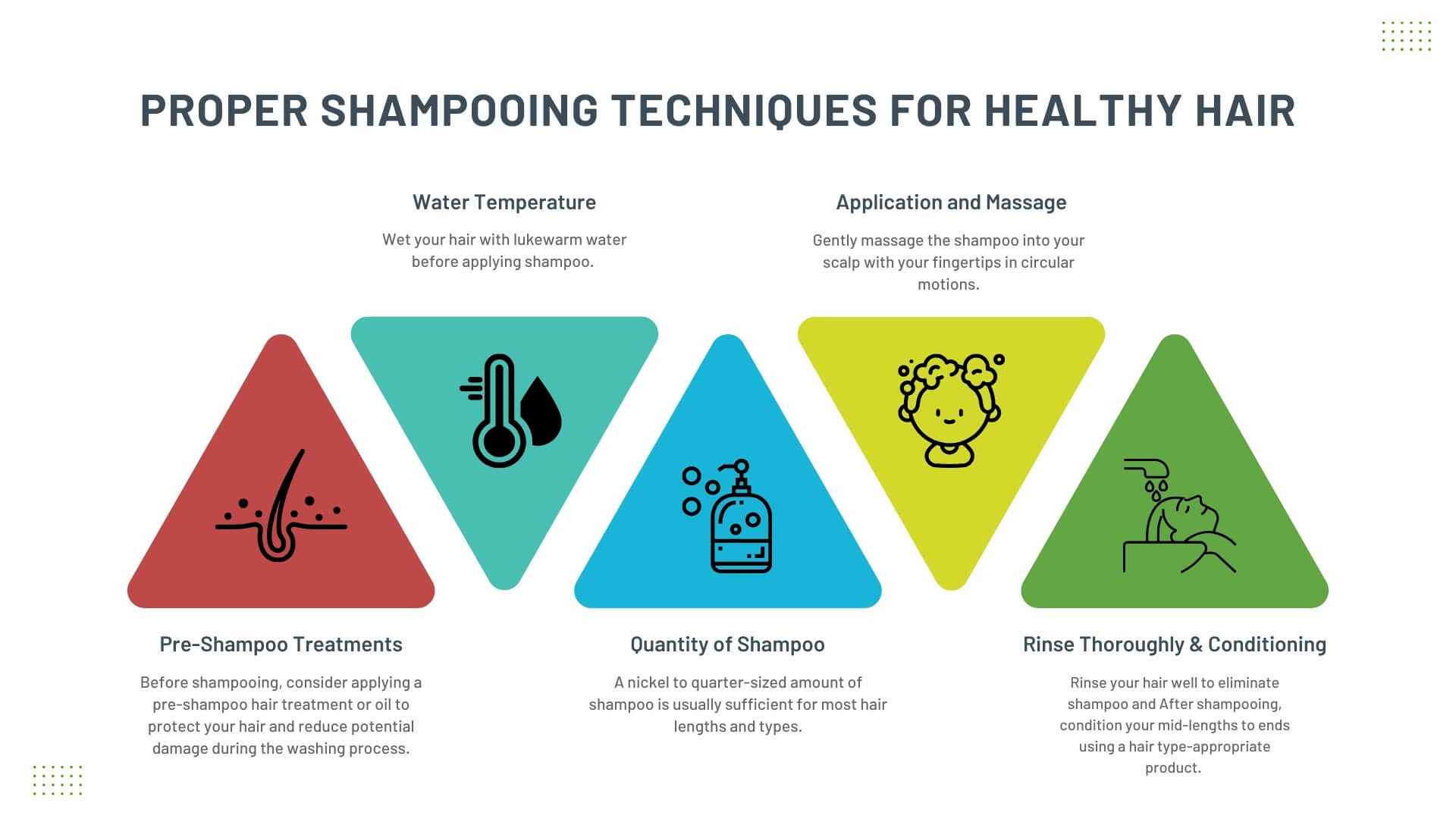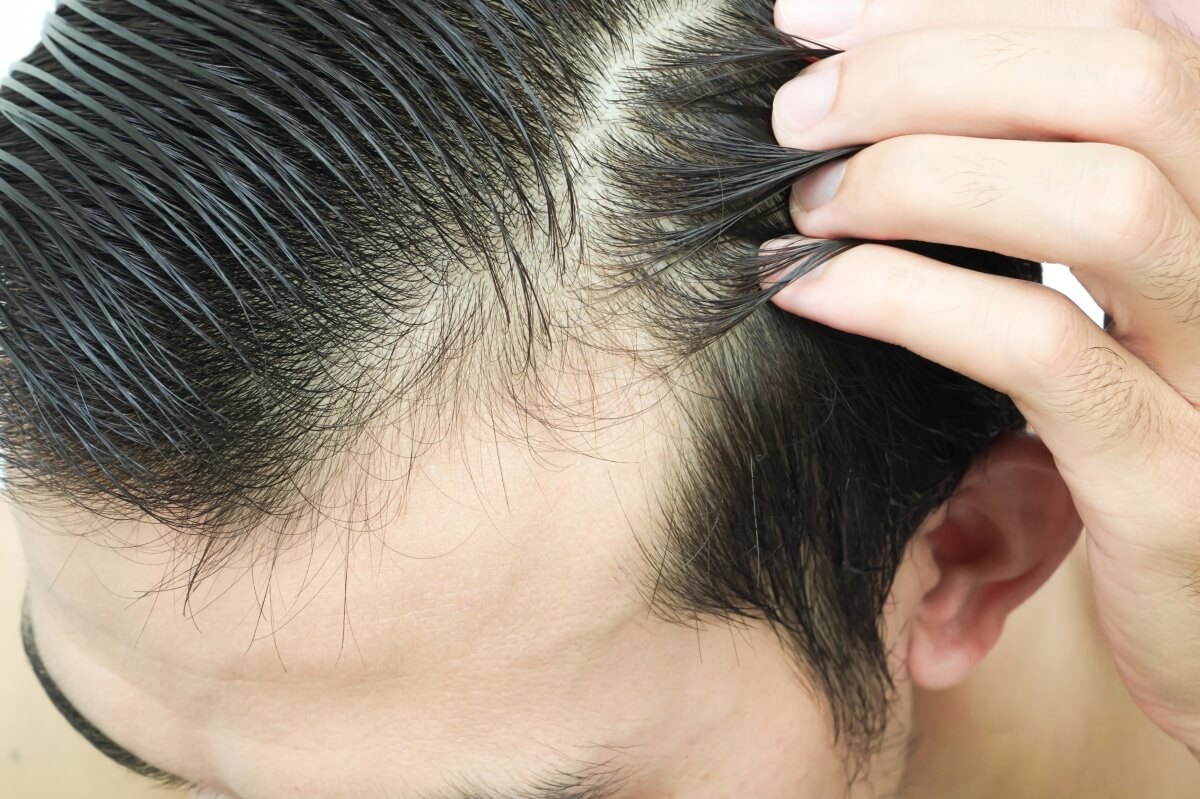Can Shampoo Cause Hair Loss?
Many of us have pondered the question, can shampoo cause hair loss? The answer may surprise you, as it’s not as straightforward as you might think. Throughout this article, we will explore the complex relationship between shampoo and hair loss, debunking a few myths along the way, and equipping you with actionable insights to protect and enhance your hair health. If you’re experiencing hair loss and seeking effective solutions, don’t hesitate to contact NeoGraft Hair Restoration in Orange County. Your journey towards a head full of healthy hair could be just one call away.
Shampoo is a hair care product that is used to cleanse the scalp and hair. It is typically made from a mixture of water, surfactants (such as sodium lauryl sulfate or SLS), emulsifiers (such as glycerin), and sometimes includes conditioners and fragrances. Shampoo is applied to wet hair, massaged into the scalp, and then rinsed out.
Most shampoos contain chemicals that can be harsh on our hair and scalp. Some of these chemicals can cause dryness, brittle hair, and even hair loss.
What Causes Hair Loss?
The average person loses 50–100 hairs a day. The fact that new hair grows simultaneously usually makes this unnoticeable. When newly grown hair does not replenish the lost hair, hair loss results.
Usually, several of these factors contribute to hair loss:
- Genetics (Androgenetic Alopecia): The most common cause of hair loss is hereditary, referred to as androgenetic alopecia or male/female pattern baldness. A person’s genes influence it, often resulting in a gradual, predictable hair thinning.
- Hormonal Changes: Hormonal fluctuations can lead to hair loss. For instance, an excess of dihydrotestosterone (DHT), a male hormone, can contribute to hair thinning in men. In women, hormonal changes during pregnancy, menopause, or the use of birth control pills can also trigger hair loss.
- Stress: Emotional or physical stress can disrupt the hair growth cycle, leading to telogen effluvium. That typically results in excessive shedding and thinning of hair.
- Supplements and medications: Drugs used to treat arthritis, cancer, depression, heart issues, gout, and high blood pressure can have side effects, including hair loss.
- Hairstyling and Treatments: Tight hairstyles like cornrows or braids, frequent use of strong hair treatments, and excessive heat styling can harm hair and lead to hair loss.
It’s important to note that the specific cause of hair loss can vary from person to person. Suppose you are experiencing significant hair loss or have concerns about your hair. In that case, it is advisable to consult a healthcare professional or a dermatologist who can diagnose and recommend appropriate treatments or lifestyle changes to address the underlying cause.
Does shampoo contain something that may damage your hair?
It’s conceivable. The amount will vary depending on the shampoo you use. Shampoos provide several vital tasks in addition to cleaning your hair and scalp, such as:
- Offer cosmetic benefits (pleasant feel and smell)
- Remove any prior hair products.
- Avoid skin irritation
- Address issues with the hair or scalp (such as dandruff or greasy or oily hair).
Some shampoos contain up to 30 different substances to do all of this, including diverse chemicals that aid in the stability and presentability of a shampoo.
Every one of these factors has a unique purpose. However, some of these may result in other health concerns. Certain components may be taken out of cosmetic items if further research exposes their negative effects on health.
Now, let’s go through some common shampoo ingredients, followed by those that might be related to hair loss.
Common Shampoo Ingredients

Common Shampoo Ingredients in Newport Beach, California at Neograft Hair Restoration Orange County
You can discover the following common ingredients in your shampoo:
- Detergents: These are the main cleansers that aid in removing oil and dirt; they are typically surfactants. Typical examples are various sulfates, such as sodium laureth and sodium lauryl sulfate.
- Conditioners: They lessen static and help make hair glossy and manageable. Dimethicone and propylene glycol are two examples found in shampoo.
- Thickeners and opacifiers: It does not affect cleansing; instead, it gives the shampoo a richer, more enticing feel. Sodium chloride and glycol distearate are two examples.
- Sequestering agents: These help in preventing the formation of soap scum. One such is ethylenediamine tetra-acetic acid.
- Preservatives: These prevent germ growth and extend the life of the shampoo. Common examples are formaldehyde releasers and parabens such as quaternium-15, 5-dimethyl (DMDM) hydantoin, and 1,3-dimethylol-5.
- Special additives: These consist of items like vitamins and chemical sunscreens.
What Types of Hair Loss Are Associated with Shampoo?
Hair loss can be a distressing concern for many individuals, and various factors can contribute to it. While shampoo is generally used for cleansing the hair and scalp, certain types of hair loss can be associated with the use of shampoo.
It’s important to note that these instances are relatively rare and may depend on individual sensitivity or specific shampoo ingredients.
Here are some types of hair loss that can be linked to shampoo:
- Allergic Reactions: Some people may be allergic to certain ingredients found in shampoos, such as fragrances, preservatives, or sulfates. In severe cases, allergic contact dermatitis can lead to scalp irritation, redness, itching, and hair loss due to continuous scratching and inflammation.
- Chemical Damage: Overusing shampoos that contain harsh chemicals or frequent use of hair products like dyes and relaxers can weaken the hair shaft, making it prone to breakage. That can result in hair thinning and eventual loss.
- Scalp Conditions: Shampoos that do not effectively address specific scalp conditions, such as dandruff or psoriasis, can exacerbate these issues. Chronic scalp conditions can lead to hair loss if left untreated.
- Overuse of Styling Products: Shampoo alone may not cause hair loss, but when combined with excessive use of styling products like gels, sprays, or heat styling tools, it can lead to hair damage and loss over time.
If you suspect your shampoo is causing hair-related issues, consider switching to a milder, sulfate-free formula or consulting a dermatologist for a proper evaluation and personalized advice.
The Relationship Between Shampoo and Hair Loss
Regular shampooing is a fundamental part of hair care to maintain scalp hygiene. However, not all shampoos are created equal, and their formulations can significantly affect your hair’s health. Ingredients in some shampoos can lead to scalp irritation or exacerbate existing conditions such as dermatitis, which, in turn, can contribute to increased hair shedding. Harsh chemicals like sulfates, parabens, and certain alcohols can strip the hair of its natural oils, leading to dryness, brittleness, and susceptibility to hair breakage and hair fall.
Furthermore, specific ingredients may trigger allergic reactions in sensitive individuals, resulting in scalp inflammation and, ultimately, affecting hair follicle health. This may not only cause hair shedding but can also interfere with new hair growth. It’s crucial to understand the ingredients in your shampoo and how they interact with your scalp and hair type. Opting for gentle, sulfate-free formulations can be a good practice to minimize potential adverse effects on hair health.
Excessive Shampooing and its Effects on Hair Health
While shampooing itself is not directly responsible for hair loss, excessive shampooing can lead to adverse effects on hair health. Overwashing your hair can strip it of essential oils and moisture, leading to a dry and irritated scalp. This creates an environment susceptible to hair breakage and hair fall. The natural oils produced by the scalp serve to protect and nourish both the scalp and hair. Stripping these away too frequently can weaken hair strands, making them more prone to breaking and falling out.
Additionally, excessive shampooing can disrupt the natural growth cycle of hair follicles, leading to increased hair shedding. When the scalp’s health is compromised by over-cleansing, hair follicles can weaken, and in some cases, this might lead to premature hair fall. Balancing your hair care routine is crucial, limiting shampooing to a frequency that keeps your scalp clean without over-drying it. This might mean washing hair less frequently than daily, depending on individual needs and hair type.
While shampooing is essential to hair care, understanding the relationship between shampoo and hair health is crucial in preventing unnecessary hair loss. Choosing the right shampoo formulation for your hair type and avoiding excessive shampooing can help maintain your scalp’s health and reduce the risk of hair shedding, breakage, and fall. Remember, healthy hair starts with a healthy scalp, so paying attention to how your shampooing habits affect your scalp and hair is vital to keeping your locks lush and strong.
Proper Shampooing Techniques for Healthy Hair

Proper Shampooing Techniques for Healthy Hair in Newport Beach, California at Neograft Hair Restoration Orange County
Proper shampooing techniques play a crucial role in hair hygiene, hair maintenance, and overall scalp health, which is essential for preventing hair loss and encouraging healthy hair growth. The right approach to shampooing can help mitigate hair shedding, breakage, and fall, ensuring your hair remains strong, vibrant, and healthy. Here are some key aspects of proper shampooing techniques:
- Pre-Shampoo Treatments: Before shampooing, consider applying a pre-shampoo hair treatment or oil to protect your hair and reduce potential damage during the washing process. These treatments can help nourish the scalp and hair, provide an extra layer of moisture, and make it easier to detangle hair, thereby reducing breakage.
- Water Temperature: Wet your hair with lukewarm water before applying shampoo. Hot water can strip your hair of its natural oils, leading to dryness and breakage, whereas cold water might not effectively remove dirt and oil buildup. Lukewarm water is perfect for maintaining optimal hair hygiene without damaging the hair.
- Quantity of Shampoo: A nickel to quarter-sized amount of shampoo is usually sufficient for most hair lengths and types. Applying too much shampoo can lead to residue buildup, while too little might not cleanse effectively. Always lather the shampoo in your hands first before applying it to your hair.
- Application and Massage: Gently massage the shampoo into your scalp with your fingertips in circular motions. This can help stimulate blood flow to the scalp, promoting hair regrowth and health. Be sure not to use nails or scrub harshly, as this can irritate the scalp and lead to hair shedding.
- Rinse Thoroughly: Rinse your hair thoroughly to remove all traces of shampoo. Residue can clog hair follicles, impede hair regrowth, and degrade overall hair hygiene.
- Conditioning: After shampooing, apply a conditioner suited to your hair type from the mid-lengths to the ends. Conditioner helps restore moisture and protect hair from environmental stressors, aiding hair maintenance and preventing breakage.
Adopting these proper shampooing techniques contributes significantly to your hair’s health, paving the way for robust hair maintenance and potentially enhancing hair regrowth.
Tips for Choosing the Right Shampoo for Your Hair Type
Selecting the correct shampoo is vital for maintaining scalp health, promoting hair regrowth, and ensuring effective hair maintenance. The wide variety of shampoos available can make choosing the right one for your hair type daunting. Here are some tips to guide you:
- Understand Your Scalp Type: Your scalp type—whether oily, dry, or combination—is the primary consideration when choosing a shampoo. For oily scalps, look for clarifying or balancing shampoos that can control oil production without stripping the scalp. Dry scalps benefit from moisturizing shampoos that contain hydrating ingredients.
- Identify Your Hair Needs: If you’re dealing with specific hair concerns such as hair breakage, thinning, or lack of volume, look for shampoos to address these issues. For example, volumizing shampoos can lift fine hair, while strengthening shampoos with proteins can help reduce breakage.
- Check the Ingredients: Opt for shampoos free from harsh sulfates, parabens, and alcohol that can strip hair of its natural oils, leading to dryness and breakage. Instead, seek shampoos with nourishing ingredients like natural oils, vitamins, and proteins to support hair regrowth and maintenance.
- Consider Hair Treatments: If you regularly color-treat or chemically process your hair, choose shampoos for treated hair. These formulations tend to be gentler and can help extend the life of your hair treatment while maintaining hair health.
- Consult a Professional: Consult with a hairstylist or dermatologist when in doubt. They can provide personalized recommendations based on an analysis of your hair and scalp type, ensuring that your choice supports your overall hair maintenance and regrowth goals.
By carefully selecting a shampoo that aligns with your hair type and needs, you can enhance your hair hygiene routine, reduce the risk of hair loss, and lay the foundation for healthy, vigorous hair growth.
Shampoo Ingredients That May Cause Hair Loss
Shampoo is thought to contain anywhere between ten and thirty different ingredients, including additives, special care ingredients, conditioning agents, and cleansing agents (surfactants). Hair loss has been linked to a few of these components. Clinical research is, however, rare.
Sulfates
Chemicals called sulfates have strong cleansing properties. The idea underlying sulfates and hair loss is that some substances, such as sodium lauryl sulfate, irritate and damage hair follicles. Breakage due to damage to a hair follicle can mimic or look like hair loss.
Formaldehyde
Low levels of formaldehyde are regarded as safe. It is used to destroy bacteria and extend the shelf life of cosmetic products. However, the International Agency for Cancer Research has classified excessive levels of formaldehyde as a group 1 human carcinogen. Numerous formaldehyde donors—chemical compounds that gradually release formaldehyde—are also included in cosmetics.
When shampooing your hair daily, you shouldn’t be directly exposed to high formaldehyde levels. However, hair products may leak formaldehyde into the air, which at certain concentrations may irritate your nose, eyes, and lungs, in addition to causing allergic dermatitis or skin sensitivity. Those who use hair straightening or smoothing solutions or work in hair salons are more likely to be exposed to this material.
Despite the goods’ claims to be formaldehyde-free, several class-action lawsuits were filed against companies that utilize DMDM hydantoin, a well-known formaldehyde source. There are claims that these products irritate the scalp and lead to hair loss. Although no clinical studies link this ingredient to hair loss, it may irritate the scalp. Additionally, hair loss is linked to an unhealthy scalp.
Keratin
Given that keratin makes up most of the hair, it makes it reasonable that treatments frequently contain it. These treatments aim to make your hair stronger and shiny while lowering frizz.
However, there are issues with this fantastic cosmetic product. First, formaldehyde, known to be bad for hair and health, is frequently used in keratin treatments.
Secondly, hair that has had keratin treatments may become brittle because of the intense heat, leading to fallout and breaks.
Dimethicone
One kind of silicon product found in hair products is dimethicone. Although silicon protects your hair, it can accumulate over time. This buildup may block your scalp’s pores, depriving your hair of moisture and nutrients and causing hair loss. But there’s no study to support this theory. Using dimethicone and all silicon products cautiously and stopping them if you see buildup or hair loss may be the best action.
Which shampoos and treatments are connected to hair loss?
Many complaints have been made stating that specific products or ingredients cause hair loss, yet there isn’t enough evidence to support these claims. The main concerns with these products and treatments are listed here.
Unilever TRESemmé Keratin Conditioners and Shampoo
There have been numerous reports of severe burns to the scalp and hair loss following the use of TRESemmé keratin products containing DMDM hydantoin. Several states have seen the filing of class-action lawsuits against Unilever over these products. In addition, Unilever (the company that recalled their product in question) resolved a previous, similar complaint.
Johnson & Johnson OGX shampoo
Johnson & Johnson is the target of a class-action lawsuit regarding its OGX shampoo and several other hair products. Many people using OGX products with DMDM hydantoin have complained of hair loss and scalp irritation.
Straight Arrow Mane ‘n Tail Conditioners and Shampoo
DMDM hydantoin-containing Mane’ n Tail products have been linked to bald patches and scalp irritation for some people. Because Straight Arrow products use formaldehyde releasers in multiple of its products, a class-action complaint has been launched against the company.
WEN hair products
After using specific WEN hair products, many people complained of hair loss. WEN’s manufacturers were the target of class-action lawsuits, which ended in a settlement. These goods were the subject of an earlier inquiry by the FDA. The ingredients that may have caused these reactions are unknown, and the investigation remains underway.
DevaCurl hair products
Some cases claimed that specific DevaCurl products caused breakage, irritation, and hair loss on the scalp. Following the consolidation of these lawsuits, mediation has begun.
Reading about other people’s experiences using specific products might be informative, but remember that different people may react differently to various chemicals. Furthermore, remember that a settlement doesn’t mean the product manufacturer acknowledges liability.
How Much Shampoo Should Be Used Each Time We Wash Our Hair
The amount of shampoo that should be used each time we wash our hair depends on the length and thickness of our hair. For short or thin hair, a small amount of shampoo (about the size of a quarter) may be sufficient. For long or thick hair, a larger amount (about the size of a golf ball) may be necessary.
How Often Should We Wash Our Hair
The frequency with which we wash our hair is also important. If we wash our hair too often, we can strip it of its natural oils, leading to dryness and breakage. On the other hand, if we don’t wash our hair often enough, dirt and oil can build up, leading to scalp irritation and possible hair loss.
The American Academy of Dermatology (AAD) recommends that people with healthy hair wash it every two to three days. People with oily hair may need to wash their hair daily.
How to Tell if You’re Using Too Much Shampoo
If you’re using too much shampoo, you’ll notice that your hair feels stripped of its natural oils. It may look dry, brittle, and frizzy. It may also tangle more easily.
If you think you might be using too much shampoo, try washing your hair less often. You may also want to switch to a gentler, sulfate-free formula.
How to Prevent Hair Loss Caused by Shampoo
The tips listed below help you avoid excessive hair loss when shampooing.
- Determining your hair type and scalp is the first and most important step in stopping hair loss.
- Create a hair care routine for your hair type, scalp, and concerns.
- Before every hair wash, massage the scalp using hot oil, like coconut, jojoba, argan, or almond oil.
- Use a mild, gentle, sulfate-free shampoo whenever possible, especially for your scalp.
- Refrain from brushing your hair while wet or in the shower. When your hair is wet, the strands are the weakest. You will only experience increased hair loss if you brush in that condition.
- After washing your hair, always use a hair conditioner. In addition to sealing in moisture, an excellent hydrating conditioner lowers the chance of damage, dryness, and hair loss. Additionally, look through the ingredients of the hair conditioner. It must include hydrolyzed keratin, butter (such as mango or shea butter), natural oils, and other ingredients that strengthen your hair.
- Use vitamin B5 and vitamin E-containing hair care products.
- After your hair has dried, gently comb through it with a gentle brush.
- Limit your time using heat-styling items and products on your hair, such as a dryer or curling rod.
- Steer clear of tight accessories and hairstyles that could pull or bind the hair uncomfortably or unpleasantly. Your hair roots will be harmed if you do this frequently or for extended periods, accelerating hair loss.
Alternative Ways to Clean Our Hair Without Using Shampoo
There are a few alternative ways to clean your hair without using shampoo.
One method is to use a conditioner only. This is also known as the “no poo” method.
Another way is to use a baking soda and water mixture to clean your hair. You can also use diluted vinegar to rinse your hair after washing it with baking soda.
Washing your hair with just water is another alternative. This method is called co-washing.
Finally, you could try using dry shampoo if you don’t want to wash your hair with water at all.
While shampoo is necessary for keeping our hair clean and healthy, some people worry that it may also cause hair loss. There is no evidence that shampoo itself can cause hair loss. However, if we shampoo our hair too often or use a harsh shampoo, it can strip our hair of its natural oils, leading to dryness and breakage. This can make our hair appear thinner and weaker, and may eventually lead to hair loss.
To avoid this, the AAD recommends using a mild shampoo and only washing our hair
If you’re experiencing hair loss, you may want to consider a hair transplant in Orange County CA. This is a surgical procedure that involves taking hair from one area of the scalp and transplanting it to another.
Orange County Hair transplants are usually only recommended for people with severe hair loss. They’re also very expensive, so it’s important to weigh all your options before deciding on this treatment.
Dr. George Brennan is a hair transplant surgeon in Newport Beach CA with over 40 years of expertise.
FAQs: Can Shampoo Cause Hair Loss?
1. What are the common causes of hair loss?
Hair loss can result from genetics, hormonal changes, stress, certain medications, and hairstyling practices. Each of these factors can contribute to hair shedding or thinning differently.
2. How does stress affect hair loss?
Stress can disrupt the hair growth cycle, causing a condition known as telogen effluvium. In this condition, hair prematurely enters the shedding phase, leading to temporary thinning.
3. What ingredients in shampoo might damage hair?
Ingredients like sulfates, formaldehyde, and certain alcohols can strip natural oils, irritate the scalp, or weaken hair strands, potentially causing dryness or breakage.
4. Can allergic reactions to shampoo lead to hair loss?
Yes, allergic reactions to certain shampoo ingredients can cause scalp inflammation and irritation, weaken hair follicles, and result in hair shedding.
5. What are the benefits of using sulfate-free shampoos?
Sulfate-free shampoos are gentler on the scalp, help maintain natural oils, reduce dryness, and are often recommended for sensitive or dry scalp conditions.
6. How often should hair be washed to maintain scalp health?
Washing hair every two to three days is generally recommended, though individuals with oily scalps may wash more frequently, and those with dry scalps may wash less often.
7. What is the role of conditioners in hair health?
Conditioners help hydrate, detangle, and protect hair strands, reducing the risk of breakage and maintaining overall hair strength and manageability.
8. Are there specific shampoos linked to hair loss?
Products containing DMDM hydantoin, like some TRESemmé and OGX shampoos, have been associated with hair loss and scalp irritation in consumer complaints, though direct clinical evidence is limited.
9. What alternatives to traditional shampoo are available?
Alternatives include:
- Co-washing (conditioner-only washing).
- Baking soda rinses.
- Diluted vinegar washes.
- Rinse hair with water.
10. How can hair loss from shampoo use be minimized?
To minimize potential hair loss, choose shampoos with mild, natural ingredients, avoid over-washing, and follow with a hydrating conditioner to protect and strengthen hair.
Related Posts
- Hair Restoration Statistics 2023
- Do Hair Transplants Really Work?
- What Are The Pros And Cons Of A Hair Transplant?
- Do Hair Transplants Last Forever?
- How to Stop Alopecia Areata From Spreading
- Can Dandruff Cause Hair Loss?
- What is a Neograft Hair Transplant?
- Beard and Facial Hair Transplants
- What’s the Difference Between Hair Shedding and Hair Loss?



Recent Comments